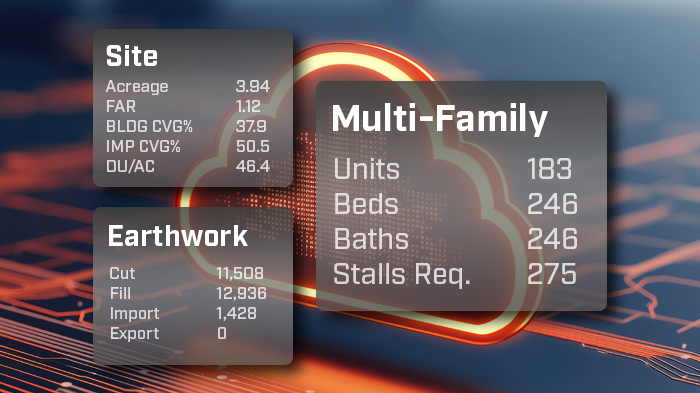
To get a building project up and running, it usually takes weeks, and sometimes months, to get a development feasibility study done.
{{form}}
Developers, architects, and contractors often don’t have enough time or financial incentive to work closely together. A critical factor is that the tools available in the market don't allow them to move fast enough.
- Developers don’t have the luxury of weeks to make decisions on a new property - they need to know if this deal pencils or not fast.
- Architects need to convert the Pro Forma into a viable spatial design that works with the site, and existing tools are highly manual.
- Contractors don’t want to invest heavily in something that might not happen. But if a project moves forward, they have to advise on cost and constructability rapidly.
In order to develop the right site plan quickly that will win the deal, you need a real estate feasibility workflow with the combined expertise of all three stakeholders.
TestFit creates a space for stakeholders to come together to integrate those different pieces of knowledge. With all that expertise at the table, you’re able to iterate rapidly, make the most of every development dollar, and reduce risk in the development process.
Fast-Track Development Feasibility Study with TestFit
Here’s a collaborative workflow for development feasibility that centers around the idea of real-time deal prototyping. We’ve found that, with most of our architecture customers, this can be done from start to finish in under 1 hour using TestFit.

1. Set Up TestFit File with Known Constraints
First, the developer can set up a TestFit file with known deal and site constraints, such as:
- Land area
- Setbacks
- Zoning parameters
- Unit types
- Parking ratios
- And more.

Watch: How to Use TestFit YouTube series to learn how to set up a TestFit file.
For multifamily projects, you can also set up standard unit types with TestFit’s Kit of Parts so the design team has base templates to work with.

With the constraints of the site, and the desired unit types, the team can now rapidly explore the potential approaches to development.
2. Iterate Live with Stakeholders
This is where the magic happens! After the developer has input those sites and deal constraints, either the developer or architect can iterate on the design in TestFit.
Rather than a typical feasibility study workflow where design options can take up to 8 hours per solution, TestFit allows developers and architects to generate and iterate through options in under 30 minutes.

From here, the contractor can give high-level feedback on the constructability of the proposed development approaches. They should also be able to improve hard cost assumptions with cost information that’s relevant to buildings in that area.
One of the biggest benefits of collaborating in TestFit is that deal iterations happen in real-time, so teams can instantly understand the tradeoffs between building program, cost, and building form.
For example, with each new iteration:
- Developer can see the yield on cost
- Architect can look at the spatial design in 3D
- Contractor can track key quantity metrics

3. Agree on a Layout and Yield on Cost Estimate
After a round of rapid iterations integrating the expertise of the developer, architect, and contractor, it’s time to commit to a winning site plan and fine-tune the deal.
The Tabulation tab on TestFit’s output panel provides key metrics for the contractor to estimate the cost of the deal. Expanding the tabulation will show instant takeoff calculations done by TestFit.

The Deals Editor allows the developer to evaluate the costs and revenue from the TestFit. They can also add key data from the Pro Forma, such as assumed costs, targeted rents, or proposed land value, without giving too much information away.

This is the sort of radical collaboration the TestFit enables—everyone has access to the information they need to do their job and can input their knowledge instantly.
Ultimately, this leads to faster site planning, better investment decisions, and happier occupants.
Accelerating Development for Real-World Projects
We’ve covered the theory, but maybe you’re still wondering what happens when the rubber hits the road. Let’s look at some real-life examples of successful feasibility studies on both multifamily and industrial deals.
A Large Multi-Family Deal
Novin Development Corp., an affordable housing developer in Walnut Creek, CA, used TestFit to fast-track development feasibility study during the extremely competitive process of securing affordable housing subsidies.
Faced with more than 30 prospective sites, the team used TestFit to move quickly through a collaborative decision-making process that led to a successful acquisition of an ideally suited site.

After outlining initial estimates with TestFit takeoffs, Novin Development Corp. brought on an architect and contractor to validate pricing and give a more detailed estimate. This initial feasibility study gave the architect a much more informed starting point to guide their initial design work, which really sped up their process.
As soon as the site was under contract, the architect went straight into design development allowing the developer to demonstrate project readiness and compete for state funding ahead much faster.

The team successfully secured $7.4m in State TOD funding, going from site plan to funding in just 2 months instead of the usual 6-8 months.
Read: How Novin Development Corp secured funding & their site 3x faster
An Industrial Development Deal
Industrial deals present a very different challenge than multifamily deals. Instead of looking at a building’s performance contextually on a site, you’re looking at how to solve a much larger logistics problem in how the building fits into a supply chain.

TestFit Industrial allows you to take parcels of land and arrive quickly to a yes/no as to whether a viable facility can work on the site.
Seeing the trade-offs between layout and operating costs in TestFit in real-time brings immediate clarity to the architecture, developer, and construction teams.
With TestFit, the starting point for discussion between stakeholders happens in days, not weeks, allowing the developer to get to that site plan quicker.
TestFit speeds up a very cumbersome process. [TestFit Industrial] helps to remove risk for developers during the site evaluation process. I believe TestFit is on its way to becoming the standard bearer for go/no-go decisions regarding the early financial wherewithal of a development deal.—Mike Jones, Executive, Pankow Builders
3 Benefits of Fast-Tracking Development Feasibility Phase
With so much at stake at the feasibility stage, fast and effective collaboration is vital. Any time wasted on a no-go site is an opportunity cost for all stakeholders.
Here are some of the key benefits of collaborating quickly in the real estate feasibility phase:
- Developers de-risk their development decisions by bringing in the expertise of their architect and contractor earlier.
- Architects are able to deliver better design services faster. That competitive edge means everything when pursuing new work.
- Contractors can find a simpler path to an estimate with a better understanding of the tradeoffs between the Pro Forma, design, and costs.
Better collaboration in feasibility is possible! If you’re ready to start fast-tracking your development feasibility study, you can book a demo with a TestFit specialist or try TestFit out for yourself.




%201.avif)



